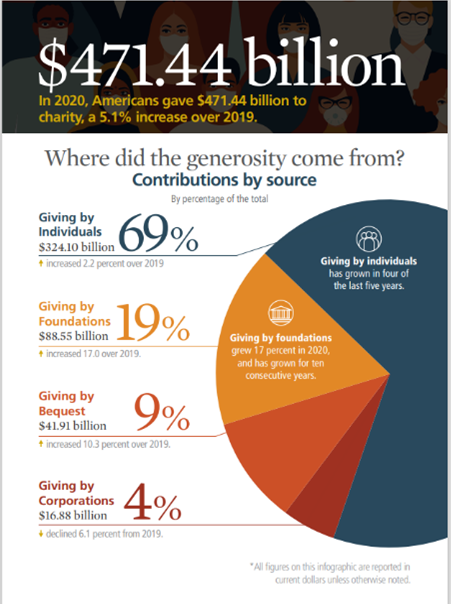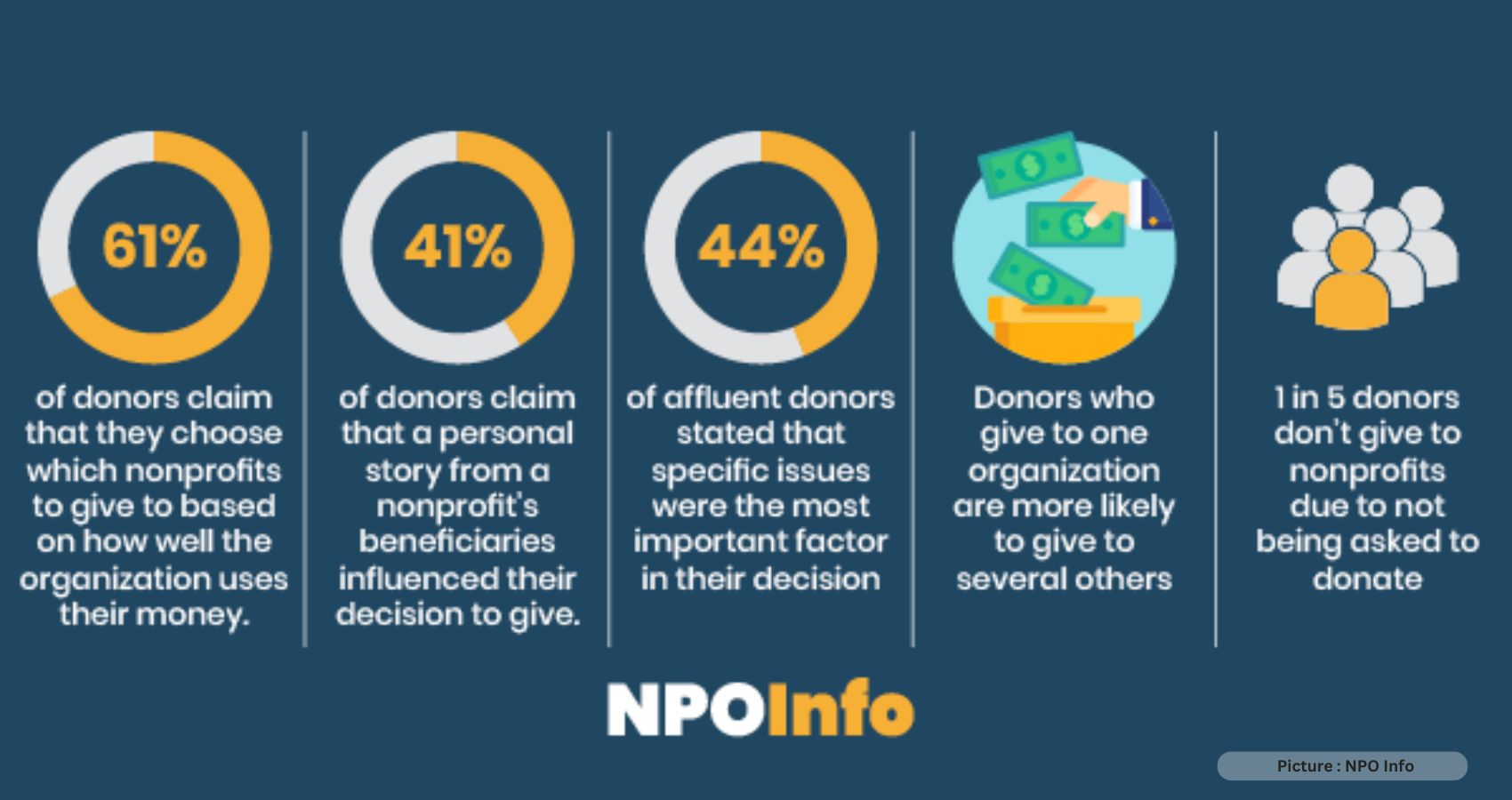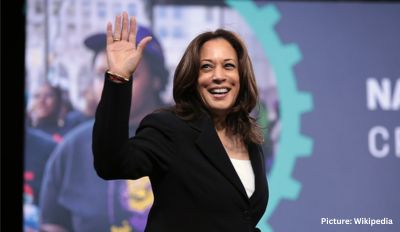Charitable giving is a deeply ingrained tradition in the United States, reflecting a blend of entrepreneurial spirit, social consciousness, and religious values. The Philanthropy Roundtable reports that over 80% of all donations to charities and nonprofit organizations in the US come from individuals, and Americans outpace their European counterparts in giving by a factor of seven. Canadians, often known for their generosity, lag behind, contributing about half as much.
The philanthropic landscape in the US can be attributed to three unique elements:
1.Entrepreneurial Spirit: The American dream is synonymous with achieving success and giving back. Many individuals and corporations consider it a duty to help those less fortunate once they’ve achieved their goals.
2.Social Consciousness: From national organizations like the ACLU to local food banks and disaster relief funds, Americans have a rich tradition of assisting their neighbors in times of need.
3.Religion: The United States remains one of the most religious countries globally, with regular giving to churches, synagogues, mosques, temples, and other religious institutions forming an integral part of many Americans’ lives.
Now, let’s delve into the details of charitable giving in the US.
Percentage of American Households Engaging in Charitable Giving
The Philanthropy Roundtable reports that 60% of American households engage in charitable giving, reflecting the nation’s commitment to helping those in need.
Trends in Charitable Giving
Even amidst the global COVID-19 pandemic in 2020, charitable giving in the US continued to follow an upward trajectory. Charity Navigator, a watchdog for charities and nonprofits, notes that since 1977, Americans have increased their giving every year, with a few exceptions in 1987, 2008, and 2009. In this sense, 2020 simply continued the trend of giving more than the previous year.
Religious Giving
Determining which religious group is the most charitable is a complex task due to the diversity of America’s religious makeup. However, recent studies shed some light:
– Jews and Muslims donate more to public society benefit organizations involved in civil rights and social inequalities compared to their Christian and non-Christian counterparts.
– Among Christian groups, Mormons emerge as the most generous, followed by Evangelicals, Protestants, and American Catholics, particularly in the areas of family, children, and human services and causes.
– Jews stand out for their donations to non-Jewish organizations, showcasing the varied giving habits across different beliefs and traditions.
Average Charitable Contributions
The average annual charity donation for Americans in 2020 stood at $737 according to Giving USA. However, this figure can be misleading due to disparities:
– High net worth families donated an average of $29,269.
– For the general population, the average donation was only $2,514.
– The average online donation amounted to $177.
– Non-profit websites received an average of $1.13 from each visitor.
– Many Americans also contribute in-kind donations, such as goods to organizations like Goodwill, the Salvation Army, and local charities, as well as food pantries, which are often not monetarily quantified.
Thus, the average charitable contribution varies significantly based on income, donation method, and recipient.
Charitable Giving by Month
December is the peak month for charitable giving, maintaining its status as the preferred time for generosity in both 2019 and 2020. However, there are interesting nuances:
– In 2020, during the height of the pandemic, charitable giving experienced significant declines in March, April, and May, as reported by Nonprofit Source.
– Charities with recurring monthly giving programs receive an average of $52 each month per donor, showing the effectiveness of this approach.
– Donors who set up recurring monthly donations give 42% more than one-time givers, according to Nonprofit Source.
The Psychology of Asking for $19 a Month
Charities often request donations of $19 a month for two key reasons:
1.Psychology: Studies on consumer behavior suggest that prices ending in numbers like 4, 7, and 9 are perceived as more affordable and appealing. Thus, $19 appears more manageable than $20 to potential donors.
2.IRS Requirements: Charities and nonprofits must provide receipts for annual donations totaling $250 or more. Requesting $19 monthly ensures that the yearly total ($228) falls below this threshold, saving time and costs associated with sending receipts.
Charitable Giving Demographics
Understanding the demographics of charitable donors provides valuable insights:
Age Group: The average age of US donors is 64, predominantly representing the Baby Boomer generation.
Geographical Distribution: Utah stands out as the most charitable state in the US, with over half of the top ten states for total giving located in the South. This correlates with the generosity of Mormons and Evangelical Christians, who are among the country’s most significant donors.
Motivations for Charitable Giving
Research has identified seven key reasons why people give to charities:
1.Happiness: Giving triggers the release of dopamine, the “feel-good” chemical in the brain, leading to increased happiness.
2.Empowerment: Donors feel empowered when they witness their contributions directly benefiting their chosen causes.
3.Personal Connection: Many donors have personal or emotional ties to specific charitable causes.
4.Trustworthiness: Donors prefer charities and nonprofits with a track record of tangible impact.
5.Community: Being part of a larger community and making a difference motivates donors across various sectors, from animal welfare to the arts.
6.Awareness: Charities that effectively capture donors’ attention through advertising, social media, or community events tend to receive more support.
7.Tax Benefits: Tax deductions for charitable donations motivate a significant portion of donors, including those with modest incomes.
Charitable Giving by Income Group
A closer look at charitable giving by income brackets reveals some unexpected trends:
- Those earning less than $50,000 annually donate a higher percentage of their income to charity.
- Conversely, those with incomes ranging from $100,000 to $500,000 give the least in terms of total charitable donations relative to their gross income.
Charitable Giving Across Generations
Let’s delve into the fascinating world of charitable giving across different age groups, from the tech-savvy Millennials to the seasoned members of the Silent Generation.
Millennials: The Tech-Savvy Donors
Millennials, often associated with digital innovation, contribute an average of $481 to charitable causes annually, with a remarkable 84% engaging in philanthropy. They have a strong penchant for online giving, frequently opting for recurring donations, with over 40% setting up monthly deductions from their credit or debit cards. Furthermore, Millennials are avid users of mobile devices, employing phones, tablets, and laptops to research charities, make donations, and advocate for various causes.
The causes that resonate most with Millennials are children’s charities, health and medical nonprofits, local places of worship, and human rights and international affairs groups.
Generation X: Balancing Giving and Volunteering
Generation X, with an average donation of $732 per individual per year, boasts a 59% participation rate in charitable giving. While their donations may be fewer in number compared to Millennials, Gen Xers are more inclined to initiate fundraising campaigns and actively volunteer for charitable endeavors. Email outreach stands out as the most influential method for engaging this generation in philanthropy.
Gen Xers’ charitable preferences align with local social and human services organizations, animal-related causes, children’s charities, and local places of worship.
Baby Boomers: Generosity Knows No Bounds
Baby Boomers exhibit remarkable generosity, averaging $1,212 in annual donations per person. An impressive 72% of the Baby Boomer generation contributes to charitable causes, representing a significant 43% of all yearly donations. Many of these Boomers, who were once 1960s activists, continue to support causes related to social justice, world peace, and environmental issues.
Their charitable support primarily gravitates toward local social services nonprofits, animal organizations, children’s charities, human rights and international affairs, and local places of worship.
The Silent Generation: Quiet Yet Impactful Giving
The Silent Generation, born between 1927 and 1946, donates an average of $1,367 annually per person, with a remarkable 88% of them participating in charitable giving. Despite comprising only 11% of the US population, they contribute a significant 26% of all charitable donations. Their giving preferences lean toward organizations that reach out via direct mail and causes featured in the news.
Silent Generation donations predominantly support veterans’ causes, local social services, emergency and disaster relief efforts, and local places of worship.
Generational Giving Trends in 2020
In 2020, amidst the challenges posed by the pandemic, only two sub-sectors of nonprofit organizations witnessed notable growth in donations. Local human and social services organizations experienced a 12% surge in giving, while faith-based giving increased by 3%. Conversely, medical researchers and arts and culture subsectors faced declines in donations.
Medical research may have been affected due to the government’s extensive investments in COVID-19 research, potentially overshadowing other medical causes. Additionally, the dominance of COVID-19 news coverage may have diverted donors’ attention away from other health-related issues. Arts, culture, and humanities groups struggled to raise funds due to the limitations imposed by pandemic-related restrictions.
Religious and Church Charitable Giving
Religious giving holds a significant place in the philanthropic landscape, with all four major generational groups contributing to local places of worship.
Most Charitable Giving by Religion
Jewish individuals top the list, contributing an average of $2,526 annually, followed by Protestants at $1,749, Muslims at $1,178, and Catholics at $1,142. Jewish and Muslim donors often direct their contributions to social and human rights organizations, while Christian giving preferences vary by denomination. Nevertheless, 32% of all donations in the US find their way to local places of worship or faith-based nonprofits.
Average Family Contributions to Local Places of Worship
On average, Americans donate $17 weekly to their local places of worship, but surprisingly, 37% of weekly attendees do not contribute at all. Only 5% of congregants are consistent givers. The average weekly church donation per person has experienced a slight decline, dropping nearly 1% since the Great Depression. During the 1930s, Christians contributed 3.3% of their total income to churches, whereas today’s faithful allocate 2.5%.
An intriguing observation is that 75% of non-religious, non-affiliated Americans engage in charitable giving, with many directing their contributions toward faith-based organizations.
Religious Organizations’ Annual Revenue: A Closer Look
Religious organizations are a significant recipient of monetary donations, with approximately one-third of all annual donations flowing in their direction. In 2020, this amounted to a substantial $128.17 billion, as revealed by an extensive survey of IRS tax returns.

While religious giving has maintained its stability at around the 30% mark for several years, recent trends suggest potential shifts on the horizon. Religious affiliation and regular attendance have been on a decline, with only 36% of American adults claiming to participate in weekly worship.
Volunteer Fundraising Insights: Statistics, Facts, and Trends
We’ve already established that Baby Boomers tend to be the most active volunteers, but there are other intriguing aspects to consider when it comes to volunteering.
The Volunteer Landscape
In the United States, a remarkable 77.34 million adults, equivalent to 30% of the adult population, engaged in volunteering in 2020. These dedicated individuals collectively contributed over 1.6 billion hours of their time, reflecting the spirit of community service.
Volunteer Time Investment
On average, American volunteers devoted 3.5 hours per week to their chosen causes, resulting in an estimated total value of unpaid labor and services amounting to a staggering $255 billion, as reported by Americorps.
Shifting Volunteer Demographics
Notably, there have been discernible shifts in the demographics of volunteers. In 2020, the typical volunteer was more likely to be:
– Married
– Female
– Aged 35-44
– White
– Possessing higher or secondary education
– A parent with children under 18
However, this trend may not persist, given the influence of the pandemic. The pandemic necessitated adjustments, particularly for working mothers who switched to remote work to accommodate their children’s needs when schools closed. This cohort may have chosen to contribute their available “non-lockdown” time to fulfill community needs and simply to escape their homes. Additionally, older generations of volunteers expressed reduced willingness to volunteer due to COVID-19 health concerns.
Volunteer Fundraising Demographics: Generational Giving Patterns
While Baby Boomers traditionally lead in overall volunteering, in 2020, the younger Gen X and older Millennial mothers emerged as the most active volunteers.
Corporate Giving: A Look into Corporate Generosity
Now, let’s explore corporate philanthropy and what businesses contributed in the previous year.
Average Corporate Contributions
Corporate donations to nonprofit organizations amounted to $24.8 billion in 2020, reflecting a 6% decline, according to Giving USA’s report. Corporate giving closely aligns with pre-tax profits, in contrast to individual giving, which exhibits a stronger correlation with stock market performance. Last year, the stock market thrived while many corporations faced profit reductions due to the pandemic’s economic impact.
Leading Corporate Donors in America
In 2020, Pfizer emerged as the most charitable corporation in the United States, according to the Chronicle of Philanthropy. Completing the list of the top five most generous organizations are:
- Pfizer
- Gilead Sciences
- Merck and Company
- Walmart
Corporate Contributions to Religious Organizations
Kroger stands out as Double the Donation Organization’s leading corporation in support of churches and other religious institutions. They generously contribute millions in both monetary funds and products to aid hunger relief, homeless support, and various programs managed by local religious entities.
School Fundraising Statistics: Impact of the Pandemic
 In 2020, fundraising for K-12 schools experienced a notable 4.6% decline, as reported by Giving USA. Typically, schools generate approximately $5000 per school each year through fundraising activities. The closure of schools due to the pandemic likely contributed to this decrease in fundraising revenues.
In 2020, fundraising for K-12 schools experienced a notable 4.6% decline, as reported by Giving USA. Typically, schools generate approximately $5000 per school each year through fundraising activities. The closure of schools due to the pandemic likely contributed to this decrease in fundraising revenues.
Online Giving Trends: A Digital Perspective on Philanthropy
Online charitable giving experienced substantial growth in 2020, which can largely be attributed to the pandemic’s influence.
Online Charitable Giving Growth
In 2020, every sector witnessed a minimum of a 15% increase in charitable giving compared to previous years, with the overall charitable giving growth rate surging by 20%.
Insights into Giving Tuesday
The popularity of Giving Tuesday has continued to rise since its inception in 2012, with $380 million raised in the most recent year.
Origins of Giving Tuesday
Giving Tuesday was initiated in 2012 by the United Nations Foundation in New York City. It falls on the first Tuesday following the Thanksgiving holiday.
Online Crowdfunding Insights
Online crowdfunding has become an essential tool for nonprofits, with notable campaigns achieving substantial success.
Notable Crowdfunding Campaigns
Two nonprofit crowdfunding campaigns that achieved significant success were conducted by Save the Children and the American Red Cross, raising $20 million and $4.7 million, respectively.
Key Factors Influencing Crowdfunding Success
Success in crowdfunding campaigns largely depends on several factors, including:
– Extensive sharing on social media, with success rates increasing with the number of social media contacts. For instance, having 10 friends share increases success by 9%, while 100 friends lead to a 20% boost.
– Comprehensive campaign descriptions ranging from 300 to 500 words.
– Regular updates to engage and inform supporters; campaigns with updates every 5 days garner three times more donations.
– The inclusion of videos in campaign appeals, resulting in a 150% increase in donations compared to campaigns without video content.
Global Nonprofit Landscape
The world boasts 1.54 million nonprofits registered with the IRS, as documented by the National Center for Charitable Statistics. This expansive array of organizations offers numerous causes to support.
In Conclusion
Even in a year characterized by unprecedented uncertainty and upheaval like 2020, the spirit of giving has endured and, remarkably, flourished. Americans continued to give, and their generosity seemed to grow even amidst adversity, social unrest, and political divisions.
This enduring generosity reflects a remarkable facet of American society.











